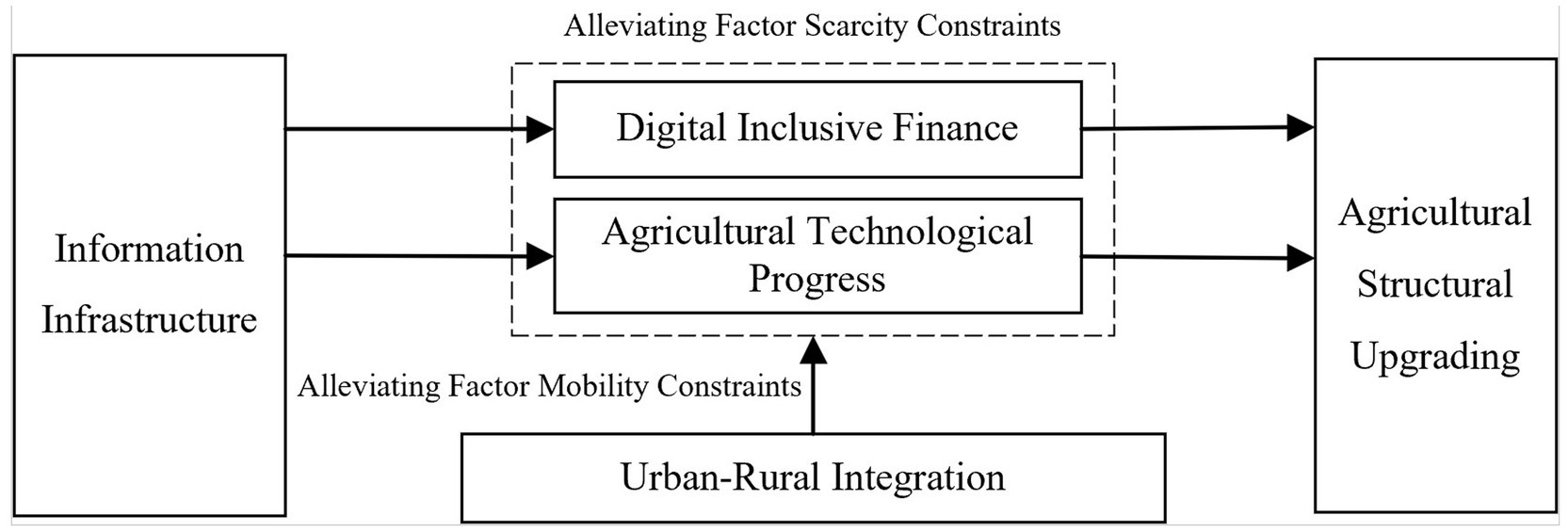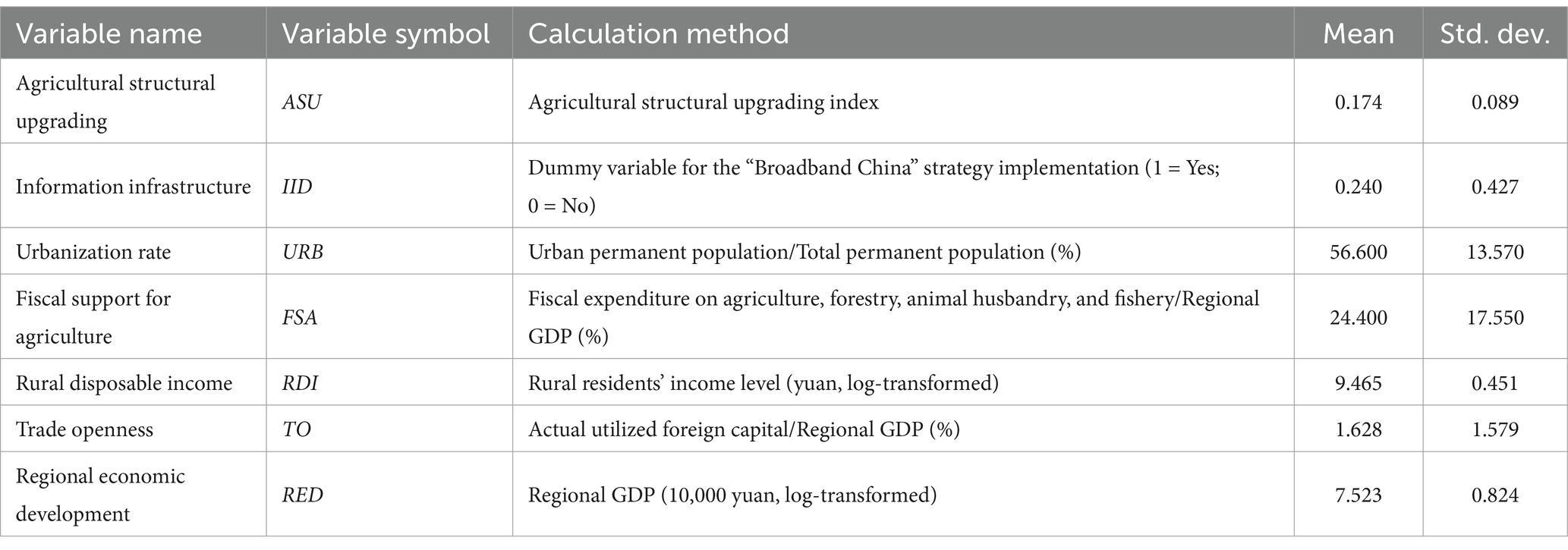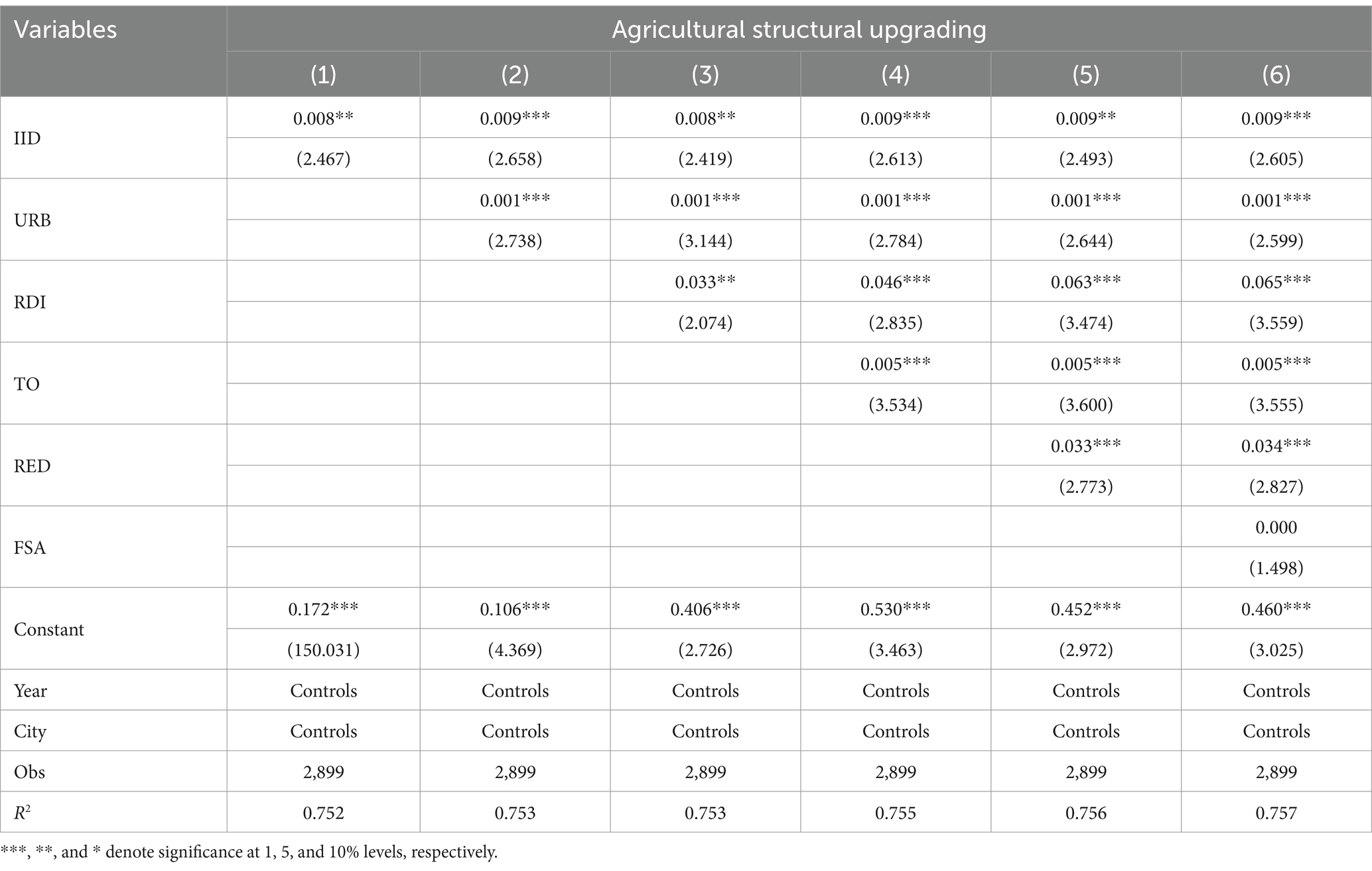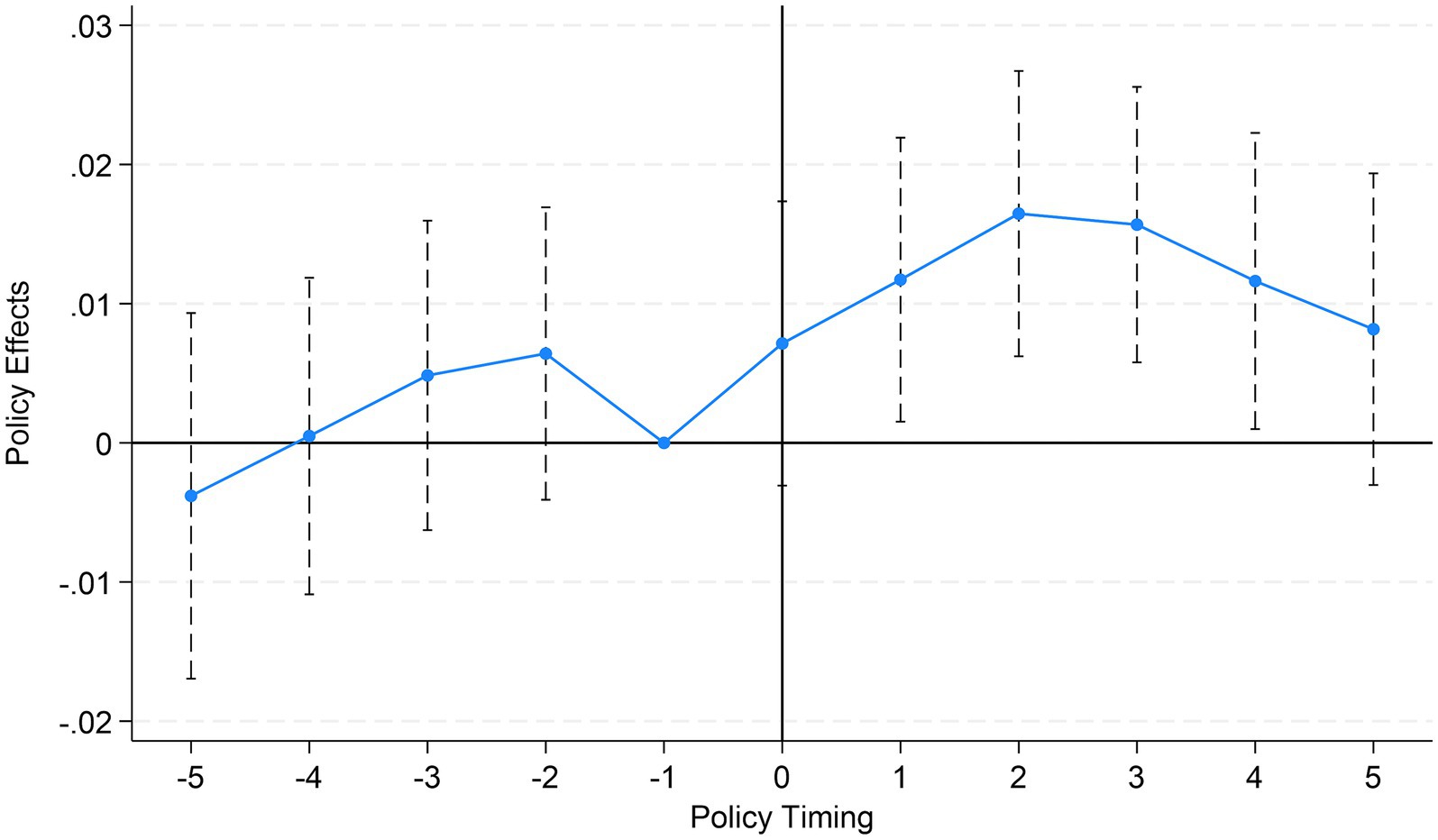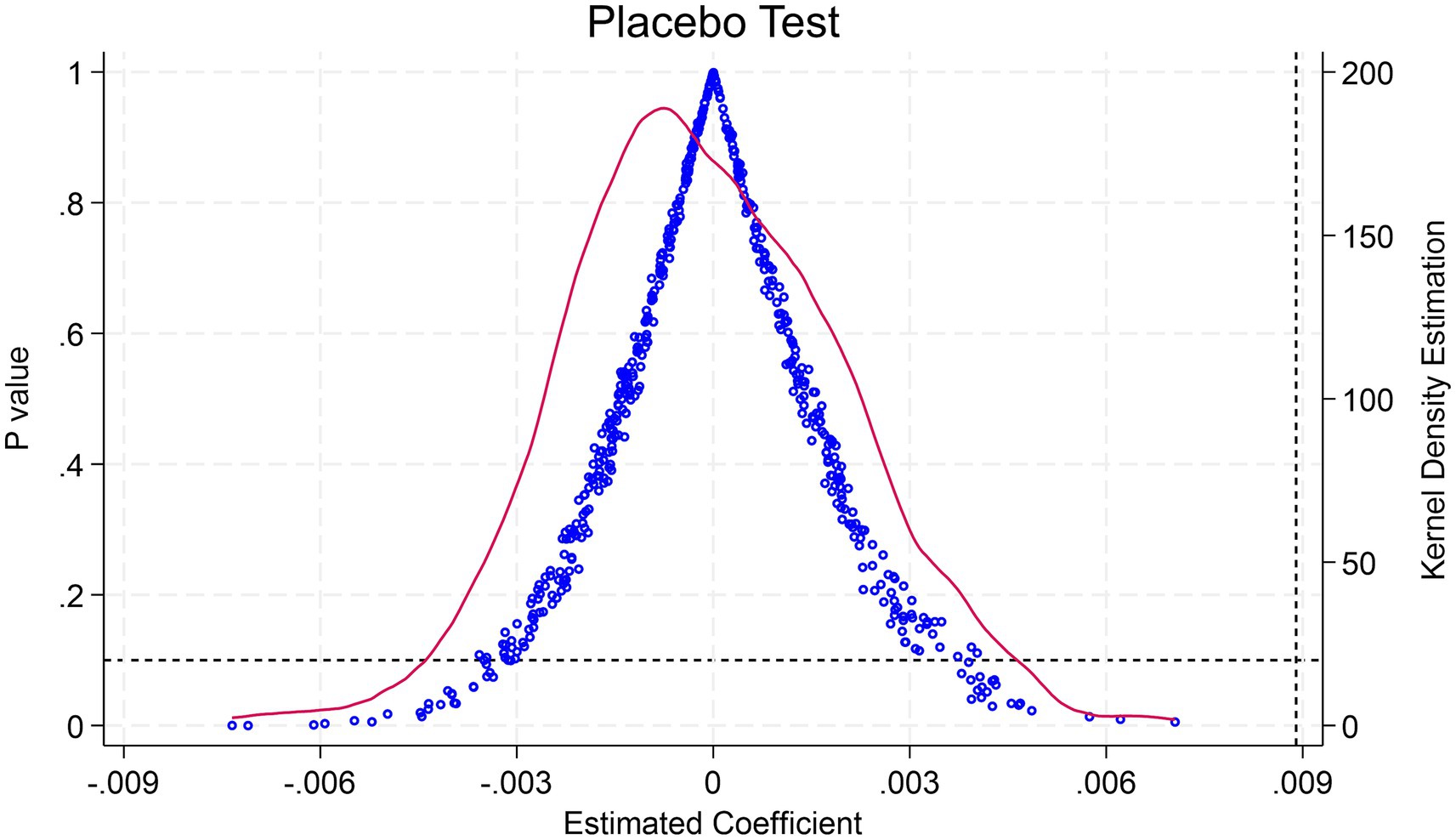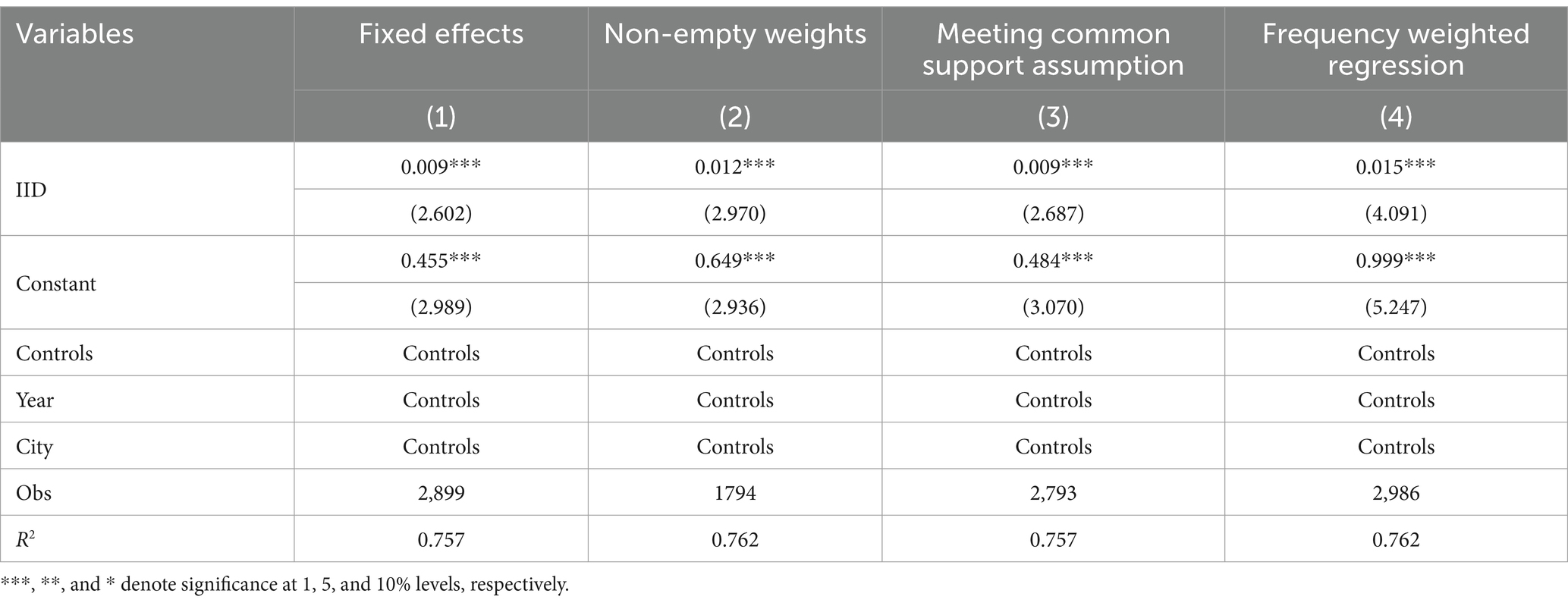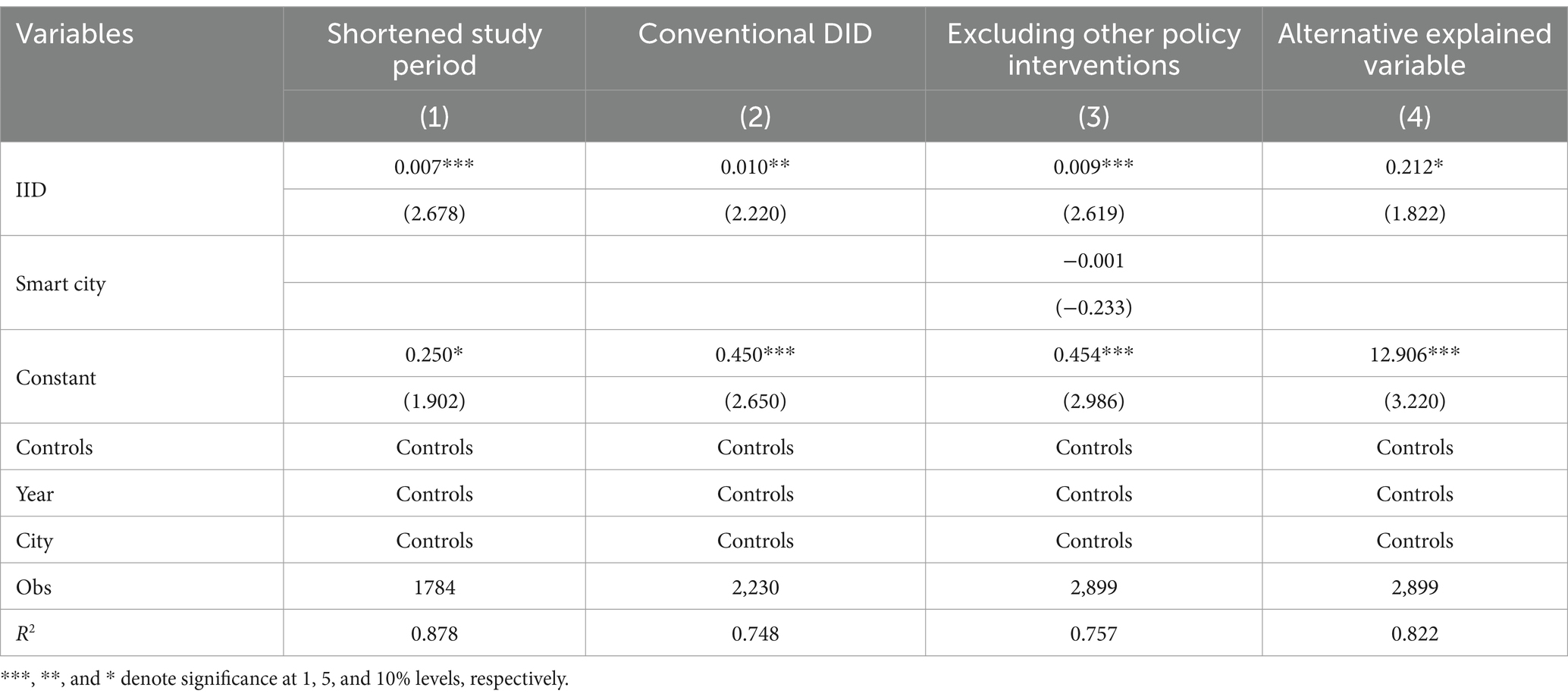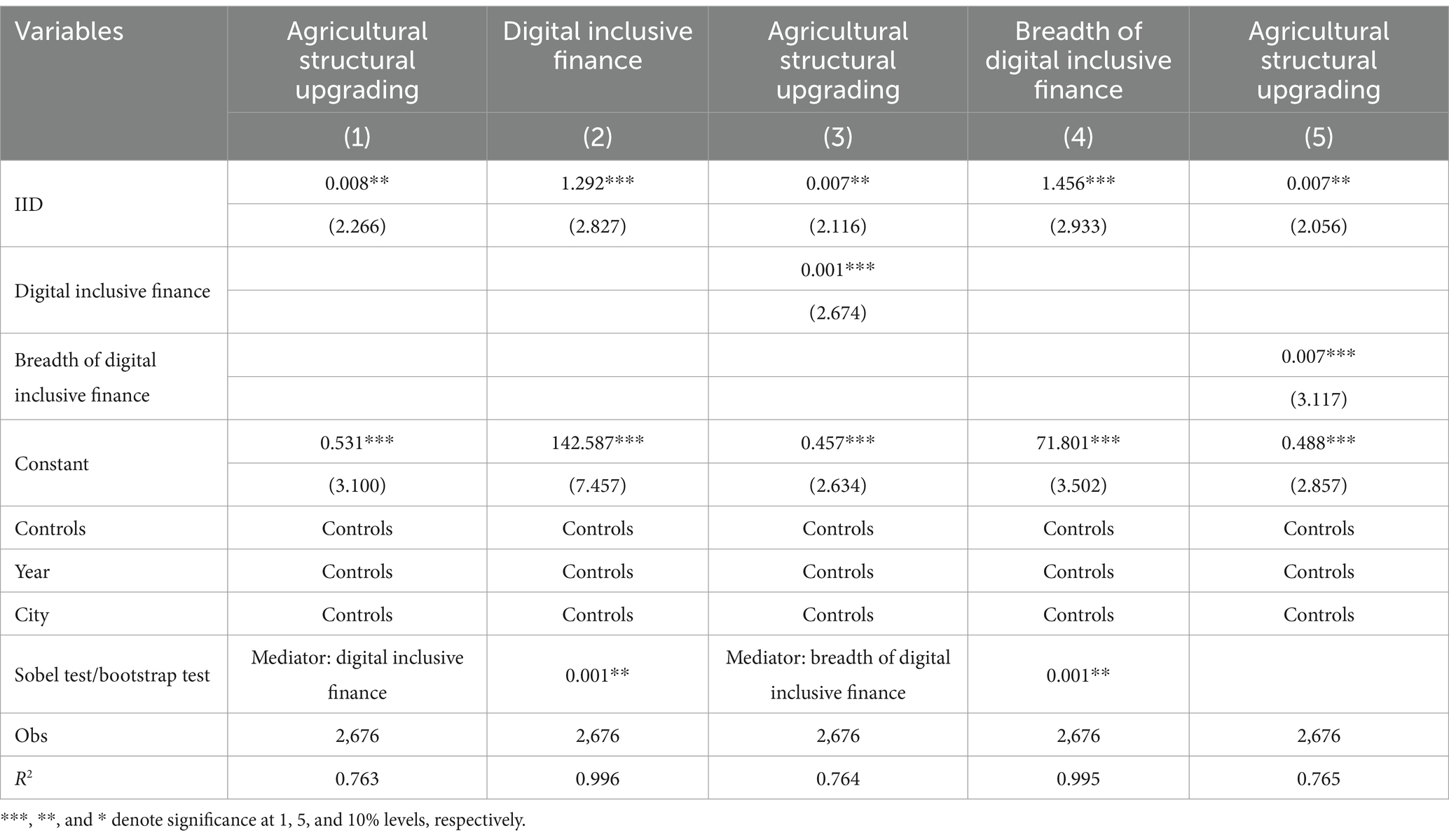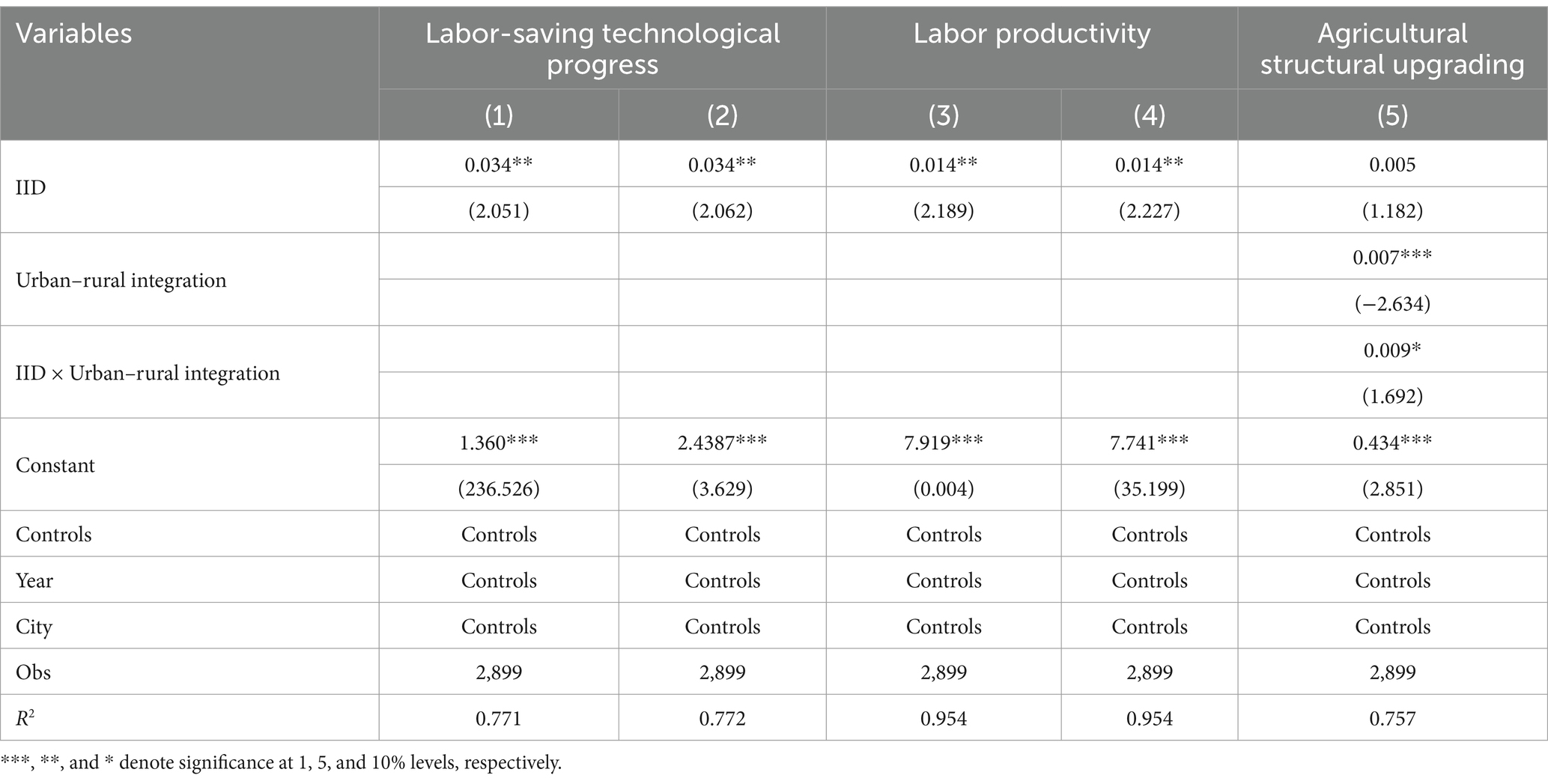- School of Finance, Nanjing Agricultural University, Nanjing, China
Introduction: The development of information infrastructure constitutes an important driver for promoting high-quality agricultural development.
Methods: Using panel data of 223 prefecture-level cities in China from 2010 to 2022, this paper employs the “Broadband China” pilot policy as a quasi-natural experiment and constructs a staggered DID model to examine the impact of information infrastructure on agricultural industrial structure upgrading.
Results and discussion: The results indicate that information infrastructure significantly facilitates the upgrading of the agricultural industrial structure, and the findings remain robust across a series of robustness checks. Heterogeneity analysis reveals that the positive effects are more pronounced in regions with better traditional infrastructure, higher population density, central and eastern locations, and major grain-producing and marketing balance areas. Mechanism analysis suggests that information infrastructure alleviates the scarcity and mobility constraints of agricultural production factors, thereby promoting structural upgrading. Based on these findings, this study recommends continued investment in information infrastructure, acceleration of agricultural innovation, and enhancement of talent cultivation to advance agricultural industrial upgrading and build an agricultural powerhouse.
1 Introduction
With global agricultural systems undergoing profound structural transformations, accelerating the upgrading of the agricultural industrial structure has become a pressing policy objective in many countries. In China, this objective is central to the pursuit of high-quality agricultural development, particularly in response to persistent structural inefficiencies in the rural economy. Since 2017, the policy focus has shifted from expanding aggregate agricultural output to addressing structural imbalances, prompting a series of supply-side reforms designed to enhance factor allocation efficiency, productivity, and value chain integration. Nevertheless, the adjustment of China’s agricultural industrial structure still faces numerous challenges, including resource scarcity and environmental pressures, low utilization rates of agricultural facilities, and imperfect market circulation mechanisms. In 2022, China’s Central Committee emphasized building an agricultural powerhouse driven by technological innovation, underscoring that both agricultural structural upgrading and high-quality development hinge on advances in agricultural science and technology. In 2025, four central ministries jointly issued the Digital Rural Development Guidelines, which reemphasized the importance of consolidating the foundational infrastructure for digital rural development. These policies underscore the strategic importance of information infrastructure in agricultural structural transformation and provide a roadmap for building a modern agricultural system and advancing digital transformation across the entire value chain. Therefore, given the dual challenges of sustainable and high-quality development goals and a rural labor shortage, accelerating the construction of information infrastructure to drive agricultural structural upgrading has significant practical importance for China’s efforts to build an agricultural powerhouse and achieve socialist modernization.
With the advancement of the ongoing technological revolution and industrial transformation, information infrastructure has emerged as a strategic foundation for advancing agricultural modernization and sustainable development globally. It plays a pivotal role in driving agricultural structural upgrading. Over the past two decades, many countries have significantly increased investment in digital infrastructure, accelerating the development of digital and modern agricultural information systems, driven by advances in information resource construction and agricultural data technologies. For example, the European Union has integrated digital technologies such as agricultural IoT, satellite remote sensing, and big data into its Common Agricultural Policy (CAP). The United States launched the Rural Digital Opportunity Fund (RDOF) to expand fiber-optic broadband coverage and improve digital access in rural areas. Australia has accelerated the development of precision agriculture through targeted investments in digital infrastructure. Despite differences in institutional settings and resource endowments, a broad consensus has emerged that information infrastructure is fundamental to agricultural structural transformation and the construction of modern agricultural systems.
Nonetheless, substantial disparities remain in the global development of digital agriculture. According to the Global Digital Economy Landscape (2020) report by the China Academy of Information and Communications Technology (CAICT), the average share of the agricultural digital economy in agricultural value added across 47 countries was 7.5% in 2019, with developed countries averaging 13.3% and developing countries only 5.9%. The United Kingdom, Germany, and the United States led globally, each exceeding 20%, while China accounted for only 8.2%. Data from 2022 indicate that the penetration rate of China’s agricultural digital economy reached approximately 10.5%. However, a substantial gap still remains compared to developed countries. This underscores the need for China to further accelerate the development of information infrastructure to more effectively support agricultural structural upgrading.
Existing research demonstrates that the optimal allocation of production factors and technological innovation serves as a critical pathway for promoting industrial structure upgrading (Shen and Ren, 2023; Zhang, 2023; Hu et al., 2022). Traditional infrastructure plays an important role by facilitating labor mobility and knowledge spillovers (Zhou, 2024). Building on this foundation, information infrastructure adds two unique advantages: it enhances factor mobility through network externalities and spillover effects (Hulten et al., 2006), and fosters the emergence of new industries and business models via intangible digital innovations (Salahuddin and Gow, 2016; Burtch et al., 2018; Niu et al., 2022). At the same time, the effectiveness of information infrastructure policies has attracted increasing scholarly attention. Donaldson (2022) demonstrates that information infrastructure enhances transparency along agricultural supply chains and promotes vertical integration within value chains. In contrast, Barbier (2023) highlights that the effectiveness of information infrastructure in Asian countries is constrained by farmers’ digital literacy. Similarly, Gizachew et al. (2024), based on survey data from Ethiopia, find that although smallholder farmers generally recognize the value of digital tools, adoption remains limited due to infrastructural shortcomings and inadequate knowledge dissemination. This indicates that the effectiveness of information infrastructure is not universal, but rather depends on institutional, technological, and stakeholder capacities. Therefore, a systematic evaluation of the impact of information infrastructure on agricultural development is of significant importance.
Whether information infrastructure can serve as an essential enabler of agricultural industrial upgrading in China remains an open question. This issue poses challenges at both theoretical and practical levels. On the theoretical front, studies have primarily examined the effects of information infrastructure on non-agricultural industrial upgrading, while its role in the agricultural sector remains underexplored. In addition, due to the unique characteristics of agriculture and rural areas, scarce production factors such as capital, labor, and technology face severe supply constraints and limited mobility (Li et al., 2023; Ma et al., 2022). The mechanisms through which information infrastructure alleviates production bottlenecks and promotes agricultural industrial structure upgrading remain unclear. On the practical front, as the material carrier of modern information technology and the driving force behind agricultural digital transformation, the importance of information infrastructure is self-evident. With the implementation of policies such as Broadband China and Broadband to the Countryside, rural network coverage has gradually improved, reaching a 66.5% internet penetration rate in 2023. However, the effectiveness of information infrastructure varies significantly across regions with different resource endowments (Bi and Yang, 2023; Zhou and Deng, 2023). Accordingly, further theoretical and empirical investigations are needed to elucidate the effects and mechanisms of information infrastructure on agricultural industrial structure upgrading.
The main contributions of this paper are as follows.
First, it extends the research frontier on the economic effects of information infrastructure. While prior studies have primarily focused on its role in promoting structural upgrading in industrial and service sectors, relatively little attention has been paid to its impact on agricultural and rural development. By leveraging the unique characteristics of China’s agricultural sector, this study contributes to a deeper global understanding of how digital infrastructure can support agricultural structural transformation, particularly in resource-constrained developing economies.
Second, it develops a dual-dimensional analytical framework centered on factor scarcity and mobility constraints. Departing from traditional approaches that typically examine individual factors in isolation, this paper highlights how information infrastructure alleviates both the scarcity and the immobility of agricultural production factors, thereby advancing structural transformation. This framework offers a novel theoretical perspective for understanding how digital technologies can catalyze agricultural modernization.
Third, it uncovers the heterogeneity and synergistic mechanisms underlying policy impacts. In addition to demonstrating the amplification effects of information infrastructure relative to traditional infrastructure investments, the study identifies the moderating roles of population density and regional resource endowments. These findings provide scientific evidence for designing differentiated policy interventions and contribute new empirical insights to the global discourse on agricultural digitalization.
Compared with non-agricultural sectors, the upgrading of the agricultural industrial structure faces more severe dual constraints related to resource scale and mobility. The growth model relying solely on factor inputs has become unsustainable, and information infrastructure offers a new perspective for promoting agricultural industrial structure upgrading. Against this backdrop, this study aims to analyze the impact and mechanisms of information infrastructure on agricultural industrial structure upgrading from the dual perspectives of resource scale and mobility constraints. Using panel data from 233 prefecture-level cities in China spanning 2010 to 2022, and leveraging the Broadband China initiative as a quasi-natural experiment, this study conducts empirical tests to examine these effects. This study not only expands the theoretical and practical pathways for optimizing the agricultural industrial structure in China, but also provides a conceptual foundation and policy implications for promoting information infrastructure and advancing high-quality agricultural and rural development. Moreover, it offers an instructive case and analytical framework for other developing countries with weak agricultural foundations, thereby enriching the global research perspective on agricultural digital transformation.
2 Theoretical analysis and research hypotheses
2.1 The conceptual framework of agricultural industrial structure upgrading
The agricultural industrial structure refers to the integration and interrelationship among five subsectors: agriculture, forestry, animal husbandry, fisheries, and agricultural services (Yu et al., 2023; Lin and Li, 2023). Agricultural industrial structure upgrading fundamentally relies on cross-sectoral resource reallocation, aiming to coordinate sectoral proportions and facilitate the evolution from lower to higher stages of development.
This study examines agricultural industrial structure upgrading from both external manifestations and intrinsic essence. Externally, upgrading is characterized by the optimization of the sectoral composition among agriculture, forestry, animal husbandry, fisheries, and agricultural services. It involves a gradual reduction in the share of crop farming and a corresponding rise in the shares of forestry, animal husbandry, fisheries, and agricultural services, indicating a shift toward a more advanced industrial structure. Internally, agricultural industrial structure upgrading reflects the progressive reallocation of agricultural resources from crop farming to other subsectors. However, the limited availability and low mobility of agricultural resources hinder efficient allocation, posing a major barrier to upgrading the agricultural industrial structure.
2.2 The impact of information infrastructure on agricultural industrial structure upgrading
Technological advancements and the development of new products and services are pivotal drivers of economic growth and industrial structure upgrading. Information infrastructure facilitates agricultural industrial structure upgrading by enhancing the supply of agricultural resources and accelerating factor mobility. Its impact can be observed across four dimensions. First, infrastructure construction entails substantial capital investment, particularly in rural information networks, transmission systems, and service platforms, which provides a material basis for capital-intensive agricultural transformation. Second, information infrastructure builds information highways that reduce spatial and informational barriers, improving labor and capital flows within and beyond agriculture (Aker et al., 2016; Li et al., 2020). Third, by enabling upstream and downstream integration along agricultural value chains, information infrastructure fosters cross-sectoral linkages and gives rise to new rural industries such as agritourism and e-commerce, thereby creating favorable conditions for agricultural structural upgrading (Wang et al., 2024c). Based on the above discussion, we propose the following hypothesis:
Hypothesis 1: Information infrastructure facilitates the upgrading of the agricultural industrial structure.
2.3 The mechanisms of information infrastructure in agricultural industrial structure upgrading
This study develops an analytical framework to systematically examine how information infrastructure promotes agricultural structural upgrading under the dual constraints of factor scarcity and limited mobility in agricultural systems. The framework consists of two interrelated dimensions. First, information infrastructure alleviates capital and technological constraints by expanding credit access through digital inclusive finance and promoting technology diffusion along agricultural value chains. Second, the external environment moderates the impact of information infrastructure by shaping the mobility of production factors. These mechanisms reinforce one another: digital finance facilitates technology adoption by easing capital constraints; technological progress enhances productivity and attracts investment; and urban–rural integration amplifies these effects by expanding market access. Overall, these three mechanisms interact dynamically and serve as key channels through which information infrastructure contributes to agricultural structural upgrading.
Under the traditional financial system, the profit-driven nature of capital and the inherent vulnerability of agriculture jointly result in widespread financial exclusion among agricultural entities. Digital inclusive finance leverages digital technologies to enhance financial resources, extend financial services to underserved populations, and improve financial accessibility and convenience, thus alleviating financing constraints for agricultural entities (Ceccobelli et al., 2012). Specifically, digital inclusive finance has the potential to overcome the spatial limitations of traditional financial systems and provide services to “long-tail” groups that were previously underserved (Holmström, 2018). Its development relies on the support of information infrastructure, which enables efficient communication platforms and data processing capabilities. Information infrastructure facilitates the expansion of remote financial services, data-based credit evaluation, and intelligent risk management in rural areas, thereby significantly improving both the coverage and efficiency of rural finance. Enhanced access to digital finance allows agricultural producers to secure greater financial support, acquire new knowledge and skills, and invest in smart and automated agricultural equipment for use in production activities. These changes contribute to the modernization and upgrading of the agricultural industrial structure. Moreover, with its low barriers to entry and cost advantages, digital inclusive finance helps align capital flows with the evolving needs of the agricultural sector. It directs resources toward emerging industries and innovation-driven domains, providing essential financial support for agricultural structural transformation. Based on the above analysis, we propose the following hypothesis:
Hypothesis 2: Information infrastructure facilitates the upgrading of the agricultural industrial structure through fostering the development of digital inclusive finance.
Against the backdrop of relatively scarce agricultural production resources, information infrastructure facilitates agricultural industrial structure upgrading by enhancing regional innovation levels and fostering agricultural technological progress. On the one hand, information infrastructure enhances regional connectivity by leveraging digital platforms and data systems, which help overcome geographic limitations and promote the flow of resources and knowledge across regions and sectors. This improved connectivity increases both the accessibility and dissemination of agricultural technologies. As innovation spreads, barriers between agricultural sub-sectors are gradually dismantled, allowing innovation resources to penetrate the entire agricultural value chain. This integration fosters internal synergies and guides agricultural production toward diversification and the convergence of agricultural and processed outputs (Wang et al., 2024a). On the other hand, information infrastructure facilitates the adoption of modern technologies in agricultural practices. It supports the development and application of precision agriculture, smart farming, and other innovative production models. These approaches not only enhance resource use efficiency but also improve the environmental sustainability and safety standards of agricultural supply chains, thereby steering the sector toward higher value-added and more sustainable structural transformation (Wang et al., 2025). Based on the above discussion, we propose the following hypothesis:
Hypothesis 3: Information infrastructure facilitates the upgrading of the agricultural industrial structure through advancing agricultural technological progress.
The restricted mobility of agricultural production factors constitutes a critical constraint on agricultural industrial structure upgrading. The level of urban–rural integration serves as an essential contextual foundation for the digital empowerment effects of information infrastructure, directly influencing the efficiency of rural factor mobility. As a digital production system, information infrastructure fundamentally relies on data and information as key inputs. Its enabling effects depend on the optimal coupling between digital and traditional production factors. Only under conditions of high urban–rural integration, where these factors can move freely between rural and urban areas, can the transformative potential of information infrastructure be fully unlocked to support agricultural structural upgrading. On the one hand, a higher degree of urban–rural integration fosters more flexible factor markets, allowing digital and technological resources to integrate effectively with conventional agricultural inputs. This accelerates the transformation of production methods and the innovation of business models, giving rise to smart agriculture, rural e-commerce, agritourism, and other emerging formats (Wang et al., 2024b). On the other hand, enhanced integration of rural and urban factor markets broadens the scope of market-based allocation, contributing to the formation of a virtuous cycle of factor agglomeration. This improves total factor productivity and provides sustained momentum for the upgrading of the agricultural industrial structure. Based on the above discussion, we propose the following hypothesis:
Hypothesis 4: Urban–rural integration positively moderates the effect of information infrastructure on agricultural structural upgrading.
In summary, based on the dual perspectives of agricultural factor scarcity and mobility constraints, this study constructs a theoretical framework to investigate the impact of information infrastructure on agricultural industrial structure upgrading. The conceptual framework is shown in Figure 1.
3 Methods and data
3.1 Model construction
This paper adopts the “Broadband China” strategy as a quasi-natural experiment and constructs a staggered difference-in-differences (Staggered DID) model to investigate the impact of information infrastructure on agricultural structural upgrading. Since the 117 pilot cities (or city clusters) under the “Broadband China” strategy were not designated simultaneously but implemented in phases across different years, a staggered DID model is appropriate. The model is specified as shown in Equation (1):
Where is the dependent variable, representing the agricultural structural upgrading index of city in year ; is the core explanatory variable, a dummy indicating whether the city has implemented the “Broadband China” pilot policy by year ,which proxies the intensity of information infrastructure development. represents a set of control variables; represents year fixed effects; represents year fixed effects; and is the random error term.
3.2 Variables
3.2.1 Explained variable
The explained variable is the agricultural structural upgrading index (IS). Existing research typically measures structural differences using the ratio of agricultural to non-agricultural value added, or depicts structural transformation through the proportion of the population employed in the primary sector (Li et al., 2024). However, such conventional indicators, which focus on output or employment shares across sectors, fail to reflect the internal evolution of the agricultural system and are insufficient for rigorously assessing the degree of structural upgrading within agriculture. To address this limitation while ensuring data availability and comparability, we follow Qin et al. (2022) and construct a composite index of agricultural structural upgrading. First, we define as the ratio of the output value of agricultural support services to the combined output of the forestry, animal husbandry, and fishery sectors. A higher value of indicates a stronger orientation toward service-based activities within agriculture and reflects a more advanced and functionally diversified industrial structure. Second, we define as an industrial structure hierarchy coefficient that reflects the transition from a crop-dominated monoculture to a multifunctional and integrated agricultural system. Finally, to comprehensively assess both the direction and complexity of structural upgrading, we apply min–max normalization to and , and aggregate them into a composite index of agricultural structural upgrading, denoted as . The composite index is calculated according to Equations (2)–(4):
Where represents the three agricultural subsectors: farming, forestry, and agricultural support services. represents the output value of sector ; represents the proportion of sector’s output value to total agricultural output value; and represents the weighting factor for each sector. The final index integrates normalized indicators and , providing a comprehensive measure of agricultural structural upgrading.
3.2.2 Explanatory variable
The explanatory variable is the level of information infrastructure. Using the “Broadband China” strategy as a quasi-natural experiment, we classify the pilot cities under “Broadband China” as the treatment group and non-pilot cities as the control group. We construct two dummy variables, treat and year. Specifically, if a city is designated as a “Broadband China” pilot city, otherwise . Similarly, if the observation year is equal to or later than the year when a city became a pilot, otherwise . Finally, information infrastructure is defined as .
3.2.3 Control variables
To mitigate the influence of other factors, the following control variables are selected: (1) Economic development level is measured by the natural logarithm of regional GDP; urbanization level is measured as the ratio of urban permanent residents to total permanent residents at year-end; resident income level is proxied by the natural logarithm of rural residents’ per capita disposable income; openness level is proxied by the ratio of actual utilized FDI to regional GDP; agricultural fiscal support level is measured as the ratio of local fiscal expenditure on agriculture to regional GDP.
3.3 Data sources and descriptive statistics
The data sources for this study are as follows: (1) the agricultural structural upgrading index and sectoral output values in agriculture, forestry, animal husbandry, and fishery are obtained from the China Statistical Yearbook. (2) The list of pilot cities designated for the “Broadband China” strategy is obtained from the official website of the Ministry of Industry and Information Technology of the People’s Republic of China. The policy was implemented in three phases, with pilot cities selected in 2014, 2015, and 2016. (3) Control variables are drawn from the China City Statistical Yearbook, provincial and municipal statistical yearbooks, and the Statistical Bulletin on National Economic and Social Development. To address missing values, linear interpolation was applied to maintain data integrity. The final dataset comprises a balanced panel of 233 prefecture-level cities in China from 2010 to 2022, serving as the basis for subsequent empirical analysis. Variable definitions and descriptive statistics are presented in Table 1.
4 Empirical analysis
4.1 Baseline regression
To mitigate the potential impact of outliers on the regression results, we winsorized all control variables at the 1% level and adopted a stepwise regression strategy. As shown in column (6) of Table 2, after controlling for year and city fixed effects and including all control variables, the coefficient of information infrastructure is 0.009, which is statistically significant and positive at the 1% level. This finding indicates that the implementation of the “Broadband China” strategy has significantly facilitated agricultural structural upgrading. Given that the agricultural structural upgrading index is standardized to the (0, 1) interval using min–max normalization, the estimated coefficient of 0.009 suggests that the Broadband China policy increased agricultural structural upgrading by approximately 0.9 percentage points on average. Using the sample mean (0.174) and standard deviation (0.089) as references, this effect represents a 5.2% relative improvement and a 10.1% change relative to one standard deviation. These findings suggest that information infrastructure construction plays a significant role in promoting agricultural structural upgrading. The results across all columns in Table 2 consistently demonstrate that the coefficient of the core explanatory variable remains positive and statistically significant under different model specifications, suggesting that the impact of information infrastructure on agricultural structural upgrading is robust. Thus, Hypothesis 1 is empirically supported.
4.2 Robustness checks
4.2.1 Parallel trend test
The premise of using a staggered difference-in-differences (DID) model is that, prior to the implementation of the policy pilot, there should be no systematic differences in the agricultural structural upgrading between the treatment and control groups, or any existing differences remain constant over time. Therefore, following Beck et al. (2010), this study adopts the event study approach to test the parallel trend assumption. The model is specified as shown in Equation (5):
Where is a dummy variable indicating whether the city is designated as a “Broadband China” pilot city in year . The policy implementation year serves as the baseline year, and represents the number of years relative to this baseline. Specifically, if , the policy had not yet been implemented in that year; if , the policy had already taken effect. To account for potential long-term effects, all pre-treatment periods beyond 5 years are grouped into a single category, and the same approach is applied to post-treatment periods exceeding 5 years, restricting to the range [−5, 5], while excluding . The parallel trend assumption requires that, before the designation of “Broadband China” pilot cities, the trends in Agricultural Structural Upgrading between the treatment and control groups should not differ significantly. Statistically, this implies that the coefficients of should be insignificant for . Conversely, after policy implementation, the “Broadband China” strategy must exert a significant impact on Agricultural Structural Upgrading, which is reflected by the coefficients of being significantly greater than zero for .
The results of the parallel trend test are shown in Figure 2, where the x-axis represents the years before and after the implementation of the “Broadband China” pilot, while the y-axis denotes the agricultural structural upgrading index. As shown, the estimated values of fail to reject the null hypothesis that they are equal to zero, demonstrating that the model passes the parallel trend test. In addition, this study conducts a joint significance test on the pre-treatment coefficients to further validate the parallel trends assumption. The results show that the F-statistic of the joint test is 0.84, with a corresponding p-value of 0.498, which fails to reject the null hypothesis that all pre-treatment coefficients are jointly equal to zero. This indicates that, prior to the policy implementation, there was no systematic difference in the trends of agricultural structural upgrading between the treatment and control groups, thereby satisfying the identification condition of the difference-in-differences model.
4.2.2 Placebo test
To rule out potential confounding factors, this study conducts a placebo test on the staggered DID model. The procedure is as follows: First, a random selection of “Broadband China” pilot cities is performed, and these cities are assigned fictitious implementation dates, thereby generating a pseudo-treatment experiment that includes both pilot cities and implementation timing. Next, the study estimates Model (5) using the newly generated placebo treatment variable. The placebo coefficients obtained from this regression serve as a robustness check for the baseline model. This process is repeated 500 times, and the distribution of the placebo regression coefficients is presented in Figure 3, with the corresponding estimation results summarized in Table 3.
The results indicate that the placebo regression coefficients are predominantly clustered around zero and follow a normal distribution. Moreover, their absolute values are substantially smaller than the true estimated coefficient of 0.009 in the baseline model, with p-values exceeding 0.1. These findings suggest that unobserved factors do not significantly affect the experimental results, further reinforcing the robustness of the baseline regression conclusions.
4.2.3 PSM-DID test
To address potential self-selection bias arising from the non-random selection of policy pilot cities, this study employs the propensity score matching-difference-in-differences (PSM-DID) method to evaluate the policy effects. Using 1:1 nearest-neighbor matching, we match control variables and compare the Logit regression results before and after matching. After matching, the coefficients of covariates across years decrease and become statistically insignificant, while the pseudo-R2 significantly declines, indicating the absence of systematic bias between the treatment and control groups. The balance test confirms the validity of the matching procedure. Thus, the PSM-DID test further supports the reliability of the baseline regression conclusions.
4.2.4 Additional robustness checks
To ensure the robustness of the regression results, this study conducts a series of additional tests, including shortening the study period, implementing a conventional DID model, excluding the influence of other policies, and replacing the explained variable. The regression results are presented in Table 4.
The results demonstrate the following: First, the study shortens the sample period from 2010 to 2022 to a narrower window around the policy intervention (2012–2018) and re-estimates the regression model. As shown in column (1) of Table 4, the sign and significance of the estimated coefficient for information infrastructure remain consistent with the baseline regression. Second, this study simplifies the staggered DID model in the baseline regression to a conventional DID model. Specifically, the three pilot phases are treated as a single event wave, and sample data from 2014 to 2016 are excluded. The multi-period DID is then converted into a standard DID model and re-estimated. As shown in column (2) of Table 4, information infrastructure continues to have a significant positive effect on agricultural structural upgrading. Third, between 2013 and 2015, China implemented the Smart City Pilot Program, which may have influenced agricultural structural upgrading by improving regional informatization. To rule out this potential confounding effect, this study introduces a smart city dummy variable and includes it in the baseline regression. As shown in column (3) of Table 4, the estimated coefficient for information infrastructure remains consistent in both sign and statistical significance with the baseline regression. Fourth, this study further replaces the explained variable with the ratio of the output value of agricultural, forestry, animal husbandry, and fishery (AFHF) specialized and auxiliary activities to total AFHF output value, while keeping other variables unchanged. As shown in column (4) of Table 4, the estimated coefficient for information infrastructure is 0.212, which is significantly positive at the 1% level, confirming the robustness of the baseline regression results.
4.3 Heterogeneity analysis
This study performs heterogeneity analysis from four dimensions: the level of traditional infrastructure development, population density, regional economic development, and regional grain production strategy.
First, agricultural production factors, agricultural productive services, and the circulation of agricultural products are highly dependent on traditional infrastructure such as roads and railways. Accordingly, the level of traditional infrastructure development may significantly influence the upgrading of the agricultural industrial structure. Second, compared to high-population-density regions, information exchange is relatively limited in low-population-density regions. As a result, the effectiveness of information infrastructure may vary significantly across areas with different population densities. Third, substantial disparities exist in topography, population distribution, and economic development levels among China’s eastern, central, and western regions. In 2022, the number of rural broadband access ports in these regions was 72.30, 59.51, and 44.51 million, respectively, exhibiting a pattern of east > central > west. Consequently, the uneven distribution of information infrastructure investment and application may contribute to regional disparities in agricultural structural upgrading. Fourth, compared to major grain consumption regions, grain-producing regions and production-marketing balance regions exhibit stronger agricultural dominance and receive greater policy support. Therefore, the interaction between information infrastructure construction and regional grain production policies may lead to heterogeneous effects on agricultural structural upgrading across regions.
To examine the heterogeneous effects of information infrastructure on agricultural structural upgrading, this study measures traditional infrastructure development by the total length of operational roads, population density by the ratio of year-end permanent residents to administrative area, and regional grain production strategy based on whether a region is classified as a major grain-producing region or a production-marketing balance region. In the baseline regression, interaction terms are introduced between information infrastructure and traditional infrastructure, population density, western regional classification, and regional grain production strategy. The regression results are presented in Table 5.
The results presented in Column (1) of Table 5 show that the interaction term between information infrastructure and traditional infrastructure is statistically significant and positive, indicating that the impact of information infrastructure on agricultural structural upgrading is more pronounced in regions with better-developed traditional infrastructure. Similarly, the interaction term between information infrastructure and population density is statistically significant and positive. This suggests that information infrastructure development is more conducive to agricultural structural upgrading in high-population-density regions, as it amplifies information flows and improves the efficiency of agricultural resource transactions. In contrast, the interaction term between information infrastructure and the western region is statistically significant and negative, indicating that the role of information infrastructure in promoting agricultural structural upgrading is weaker in the western region compared to the eastern region. This may be attributed to higher levels of informatization and human capital in the central and eastern regions, which facilitate technological innovation and application, whereas the western region’s weaker foundation in informatization and shortage of digital talent constrain the innovation and agglomeration effects of information infrastructure. Finally, the interaction term between information infrastructure and grain-producing regions is statistically significant and positive. This implies that in regions where agriculture holds a more fundamental position and receives stronger policy support, the impact of information infrastructure on agricultural structural upgrading is more pronounced. The accelerated integration of information and technology with traditional agriculture in these regions promotes the transformation of agricultural scientific and technological achievements. Furthermore, the agricultural endowment advantages of grain-producing regions amplify the resource allocation optimization effects of information infrastructure.
5 Further analysis: pathway mechanisms
5.1 Mitigating resource scarcity constraints
This study examines the mechanisms through which information infrastructure promotes agricultural structural upgrading from the perspectives of capital and technological factors. Capital factors are measured using the Peking University digital financial inclusion index, which captures the breadth of digital financial coverage, the depth of digital financial usage, and the degree of digitalization in financial inclusion. Technological factors encompass both input and output dimensions, represented by per capita agricultural machinery power and labor productivity in terms of agricultural output.
5.1.1 Capital factor pathway
To examine the capital factor pathway, this study employs the three-step method for mediation testing. Column (2) of Table 6 reports that the regression coefficient of information infrastructure on digital financial inclusion is 1.292, which is significantly positive at the 1% level. This indicates that information infrastructure significantly facilitates the expansion of digital financial inclusion. In Column (3) of Table 6, after introducing digital financial inclusion as a mediating variable, the estimated coefficient of information infrastructure remains positively significant at the 5% level but decreases from 0.008 to 0.007. This suggests that digital financial inclusion partially mediates the positive relationship between information infrastructure and agricultural structural upgrading. To further validate the mediation effect, both Sobel test and Bootstrap test are conducted. The results confirm that the indirect effect is significantly positive at the 5% level, with approximately 8.25% of the total effect transmitted through the mediation pathway. These findings indicate that information infrastructure alleviates financial resource constraints in rural areas, thereby facilitating agricultural structural upgrading. Hypothesis 2 is thus empirically supported.
To further clarify the pathway through which digital financial inclusion influences agricultural structural upgrading, this study examines its effects across different dimensions. As shown in Column (4) of Table 6, the regression coefficient of information infrastructure is 1.456, which is statistically significant and positive at the 5% level. In Column (5), after introducing the breadth of digital financial inclusion as a mediating variable, the coefficient of information infrastructure decreases from 0.008 to 0.007, indicating that the breadth of digital financial inclusion partially mediates the effect of information infrastructure on agricultural structural upgrading. However, further analysis reveals that the depth and digitalization level of digital financial inclusion do not exhibit significant mediation effects. A possible explanation is that current information infrastructure development primarily alleviates liquidity constraints in rural financial markets by expanding the coverage of financial services. Nevertheless, due to high access barriers associated with information infrastructure and internet-based financial services, the depth and digitalization level of digital financial inclusion in rural areas remain underdeveloped, thereby limiting their mediating effects.
5.1.2 Technological factor pathway
To address potential endogeneity concerns in the traditional mediation effect model, this study employs a two-step estimation approach to assess the effect of information infrastructure on agricultural structural upgrading.
As shown in columns (1) to (4) of Table 7, the estimated coefficients of information infrastructure on labor-saving technological progress in agriculture and agricultural labor productivity are 0.034 and 0.014, respectively, both of which are positively significant at the 5% level. Moreover, the sign and significance of the coefficients remain stable before and after the inclusion of control variables, indicating that the results are robust. These findings confirm that information infrastructure significantly promotes technological progress in agriculture, thereby providing empirical support for hypothesis 3.
5.2 Alleviating factor mobility constraints
In this study, urban–rural integration level is measured based on urban–rural income levels and consumption levels. The specific calculation is presented in Equation (6):
Where represent rural residents’ per capita disposable income and consumption expenditure, and urban residents’ per capita disposable income and consumption expenditure, respectively. index reflects the relative pace of urban–rural development, where a higher value indicates a higher level of urban–rural integration. Furthermore, to examine the moderating role of urban–rural integration, this study introduces an interaction term between the urban–rural integration level and the “Broadband China” strategy dummy variable into the baseline model (6).
As shown in Column (5) of Table 7, the estimated coefficient for the interaction term between information infrastructure and urban–rural integration is 0.009, which is significantly positive at the 10% level. This result suggests that a higher level of urban–rural integration significantly enhances the impact of information infrastructure on agricultural structural upgrading, thereby providing empirical support for Hypothesis 4. Urban–rural integration creates a favorable environment for the investment, construction, and application of information infrastructure. In regions characterized by higher levels of urban–rural connectivity, the flow of production factors becomes more efficient, talent mobility increases, and government service capacity improves substantially. Moreover, a more dynamic market system and more open governance structures further facilitate the transfer of high value-added industries from urban to rural areas. Through industrial integration between urban and rural regions, this process promotes the diffusion of technology, talent, and other key resources into rural areas, thereby accelerating the transformation and upgrading of the agricultural industrial structure.
6 Conclusions and policy suggestions
6.1 Conclusion
Amid the current wave of technological innovation, new infrastructure has emerged as a key driver of productivity enhancement and high-quality economic development. As a fundamental pillar of the digital economy, expanding investment in information infrastructure and integrating digital resources have become strategic priorities in China’s long-term development agenda. Against this backdrop, this study examines the impact of information infrastructure on agricultural industrial structure upgrading from the dual perspectives of factor scarcity and mobility constraints. Using panel data from 233 prefecture-level cities in China between 2010 and 2022, and employing a staggered difference-in-differences model, we provide robust empirical evidence on both the overall effects and underlying mechanisms. The main findings are as follows. First, information infrastructure significantly promotes agricultural structural upgrading. Second, the impact is more pronounced in regions characterized by better traditional infrastructure, higher population density, central and eastern locations, and major grain-producing and marketing balance areas. Third, mechanism analysis reveals that information infrastructure facilitates structural upgrading by alleviating capital and technological constraints and enhancing factor mobility. Furthermore, the level of urban–rural integration positively moderates the relationship between information infrastructure and agricultural structural upgrading.
6.2 Policy suggestions
Based on the above research conclusions, this study proposes the following policy recommendations.
First, maintain the momentum in advancing information infrastructure development and systematically implement policy pilots at the county level. Substantial investments in rural information infrastructure should be prioritized, with particular emphasis on optimizing investment structures based on regional characteristics to accelerate the digital transformation of agriculture and rural areas. Demonstration cities should be selected to deploy next-generation information network technologies, where innovative models integrating digital technologies with agricultural production can be actively explored. The development of digital agricultural products and services should be encouraged to establish replicable and scalable best practices. These efforts aim to build a strong digital foundation for promoting rural revitalization and agricultural modernization.
Second, promote the coordinated development of agricultural technology innovation and digital inclusive finance. An innovation system should be established, guided by government policy, driven by the market, and supported by multiple stakeholders. This can be achieved through the formation of strategic industry-academia-research alliances, the establishment of joint R&D centers, and the creation of specialized innovation funds to enhance the flow and commercialization of agricultural technologies. At the same time, support for new agricultural business entities should be improved through preferential land transfer policies, fiscal subsidies, and tax incentives to accelerate the adoption of digital farming technologies. Rural digital finance reforms should encourage financial institutions to develop tailored financial products and expand credit support for new agricultural entities. Such initiatives can enhance the technological innovation capacity of rural areas and foster the digital upgrading of agricultural production.
Third, establish a coordinated urban–rural development mechanism to enhance the bidirectional flow of resources and production factors. Efforts should focus on improving unified land markets through land management reform and the revitalization of idle rural land. At the same time, rural investment and financing mechanisms should be modernized by expanding fiscal support, leveraging public-private partnerships, and encouraging private capital participation in infrastructure development. To broaden financial access for new agricultural entities, innovative, value-chain-oriented financial products and services should be developed. In addition, accelerating the development of agricultural technology markets is crucial. Reforms in the ownership and transfer of scientific and technological outcomes should be deepened, supported by an improved technology service system to foster innovation-led transformation in agriculture. Together, these initiatives can improve resource allocation efficiency and promote integrated urban–rural development.
Fourth, strengthen the talent foundation for agricultural digitalization and promote the application of digital technologies in rural areas. Support policies for returning entrepreneurs should be improved by enhancing rural infrastructure, optimizing public services, and providing targeted incentives to attract professionals, graduates, and migrant workers back to rural areas. These measures can facilitate a shift from one-way talent outflow to two-way mobility between urban and rural regions. Additionally, diversified digital application scenarios should be developed around key areas such as agricultural production, rural governance, and livelihoods. User-oriented, accessible, and practically functional digital platforms must be prioritized to ensure that farmers can effectively benefit from digital transformation. These efforts will ensure that digital transformation benefits are accessible to rural populations, thereby enhancing rural vitality and inclusiveness.
6.3 Discussion
This paper employs the Broadband China strategy as a quasi-natural experiment to systematically examine the mechanisms through which information infrastructure influences the upgrading of agricultural industrial structures. The empirical findings indicate that information infrastructure effectively alleviates resource scarcity in agricultural production and exerts a more pronounced effect when factor mobility constraints are relatively low, thereby promoting agricultural industrial structure upgrading. These results are consistent with the theoretical logic that information infrastructure facilitates industrial development by optimizing factor allocation and also reinforce existing empirical evidence on the role of digital infrastructure in broader economic structural transformation.
Taking into account differences in institutional settings and agricultural resource endowments, this study situates the Chinese experience within a broader international context. Information infrastructure development in China has followed a government-led, policy-coordinated, and regionally piloted model. Supported by fiscal investment and state–enterprise collaboration, the Broadband China strategy has significantly improved digital infrastructure coverage in central and western regions, establishing an extensive and inclusive digital service system. This state-led model aligns closely with the structural characteristics of Chinese agriculture, which include fragmented smallholder farming and underdeveloped rural infrastructure. It has helped to overcome bottlenecks such as limited technological spillovers, enhanced rural areas’ ability to attract capital, technology, and human resources, and improved the efficiency of agricultural resource allocation, ultimately facilitating industrial upgrading.
By contrast, developed countries in Europe and America are generally characterized by highly intensive, large-scale agricultural systems and well-developed infrastructure. In such contexts, information infrastructure is typically advanced through a market-led, government-supported model. Platform-based tools and market-oriented incentives are employed to integrate digital elements across the agricultural value chain, thereby driving a transition toward high-tech, high–value-added, and multifunctional agricultural systems. However, such models often rely on mature institutional and market mechanisms, posing high entry barriers for countries still in the early stages of agricultural digitalization and infrastructure development.
The Chinese case thus offers valuable insights for developing countries aiming to promote agricultural digital transformation and industrial upgrading. In contexts characterized by limited agricultural resources, persistent urban–rural dual structures, and dominant smallholder economies, government-led information infrastructure investment can enhance the efficiency of factor allocation, unblock channels for the flow of information, capital, and technology, and thereby enable structural upgrading in agriculture. Nevertheless, this study also underscores that hardware investment alone is insufficient to build a sustainable modern agricultural system. Parallel efforts are needed to improve farmers’ digital literacy, strengthen agricultural technology service systems, and expand rural financial support mechanisms. Only through such coordinated and multidimensional reforms can developing countries achieve internal restructuring in agriculture, promote integration with secondary and tertiary industries, and build more resilient and diversified agricultural systems.
6.4 Research limitations
This study has several limitations that also point to avenues for future research.
First, this study employs the “Broadband China” strategy as a quasi-natural experiment to identify the impact of information infrastructure on agricultural structural upgrading. Although the analysis controls for potential confounding factors and adopts techniques such as parallel trend testing and PSM-DID to mitigate selection bias, the designation of pilot cities may still be influenced by underlying regional characteristics such as economic development and infrastructure conditions. As a result, the estimated effects may be subject to residual bias. Future research could improve identification credibility by introducing exogenous instrumental variables.
Second, this study relies on prefecture-level panel data, which is suitable for capturing the overall policy impact of the “Broadband China” initiative. However, such data are limited in their ability to capture behavioral heterogeneity at the micro level. The current dataset does not capture variation in farmers’ perceptions, adoption, and usage of information infrastructure, nor how these behavioral differences affect production factor allocation or transitions in farm management models. Future research may utilize micro-level survey data or nationally representative agricultural monitoring datasets to explore the differentiated effects and mechanisms of information infrastructure adoption on farmers’ production decisions.
Third, the panel data span the period from 2010 to 2022, broadly covering the main implementation phase of the “Broadband China” strategy. However, given the lagged effects of information infrastructure and the gradual nature of agricultural structural transformation, the current timeframe may not fully reflect its long-term impacts. Future studies should extend the observation window to assess the dynamic and sustained influence of information infrastructure on structural transformation in agriculture.
Fourth, the conclusions of this study are grounded in China’s specific institutional context, which may limit their external generalizability. China’s agricultural system is characterized by small-scale household farming, a pronounced urban–rural divide, and collective land ownership, while its information infrastructure development follows a government-led model grounded in the public goods provision framework. In contrast, countries with private property rights and market-driven mechanisms often operate under fundamentally different agricultural and governance structures. Therefore, applying these findings to other national contexts requires careful consideration of institutional heterogeneity.
Data availability statement
The original contributions presented in the study are included in the article/supplementary material, further inquiries can be directed to the corresponding author.
Author contributions
HH: Conceptualization, Funding acquisition, Project administration, Resources, Writing – review & editing. CQ: Data curation, Formal analysis, Methodology, Software, Supervision, Validation, Visualization, Writing – original draft. YW: Data curation, Formal analysis, Methodology, Software, Supervision, Validation, Visualization, Writing – original draft.
Funding
The author(s) declare that financial support was received for the research and/or publication of this article. This research was funded by the National Social Science Fund of China (Post-funded Project) in 2024: “Theoretical Logic and Practical Pathways of Rural Industrial and Commercial Capital Inflow from the Perspective of Rural Revitalization” (Grant number: 24FGLB017).
Acknowledgments
The authors thank all the students and teachers who helped with this article and the reviewers for their constructive comments.
Conflict of interest
The authors declare that the research was conducted in the absence of any commercial or financial relationships that could be construed as a potential conflict of interest.
Generative AI statement
The authors declare that no Gen AI was used in the creation of this manuscript.
Publisher’s note
All claims expressed in this article are solely those of the authors and do not necessarily represent those of their affiliated organizations, or those of the publisher, the editors and the reviewers. Any product that may be evaluated in this article, or claim that may be made by its manufacturer, is not guaranteed or endorsed by the publisher.
References
Aker, J. C., Ghosh, I., and Burrell, J. (2016). The promise (and pitfalls) of ICT for agriculture initiatives. Agric. Econ. 47, 35–48. doi: 10.1111/agec.12301
Barbier, E. B. (2023). Overcoming digital poverty traps in rural Asia. Rev. Dev. Econ. 27, 1403–1420. doi: 10.1111/rode.12962
Beck, T., Levine, R., and Levkov, A. (2010). Big bad banks? The winners and losers from bank deregulation in the United States. J. Finance 65, 1637–1667. doi: 10.1111/j.1540-6261.2010.01589.x
Bi, G. H., and Yang, Q. Y. (2023). The spatial production of rural settlements as rural homestays in the context of rural revitalization: evidence from a rural tourism experiment in a Chinese village. Land Use Policy 128:106600. doi: 10.1016/j.landusepol.2023.106600
Burtch, G., Carnahan, S., and Greenwood, B. N. (2018). Can you gig it? An empirical examination of the gig economy and entrepreneurial activity. Manag. Sci. 64, 5497–5520. doi: 10.1287/mnsc.2017.2916
Ceccobelli, M., Gitto, S., and Mancuso, P. (2012). ICT capital and labour productivity growth: a non-parametric analysis of 14 OECD countries. Telecomm. Policy 36, 282–292. doi: 10.1016/j.telpol.2011.12.012
Donaldson, A. (2022). Digital from farm to fork: infrastructures of quality and control in food supply chains. J. Rural. Stud. 91, 228–235. doi: 10.1016/j.jrurstud.2021.10.004
Gizachew, F., Kuma, B., Tafesse, A., and Lambamo, A. (2024). Digital tools and welfare: adoption determinants among ginger producers in southern and Central Ethiopia. Front. Sustain. Food Syst. 8:1443775. doi: 10.3389/fsufs.2024.1443775
Holmström, J. (2018). Recombination in digital innovation: challenges, opportunities, and the importance of a theoretical framework. Inf. Organ. 28, 107–110. doi: 10.1016/j.infoandorg.2018.04.002
Hu, J. X., Ma, G. J., Shen, C. H., and Zhou, X. L. (2022). Impact of urbanization through high-speed rail on regional development with the interaction of socioeconomic factors: a view of regional industrial structure. Land 11:1790. doi: 10.3390/land11101790
Hulten, C. R., Bennathan, E., and Srinivasan, S. (2006). Infrastructure, externalities, and economic development: a study of the Indian manufacturing industry. World Bank Econ. Rev. 20, 291–308. doi: 10.1093/wber/lhj007
Li, C. Y., Sha, Z. H., and Sun, T. (2023). Rural households' internet use on common prosperity: evidence from the Chinese social survey. Soc. Indic. Res. 170, 797–823. doi: 10.1007/s11205-023-03217-3
Li, W. H., Wang, S. M., and Deng, X. X. (2024). The impact of digital finance on business environment: mediating role of industrial structural upgrading and moderating role of digital infrastructure. Financ. Res. Lett. 67:105775. doi: 10.1016/j.frl.2024.105775
Li, J., Wu, Y., and Xiao, J. J. (2020). The impact of digital finance on household consumption: evidence from China. Econ. Model. 86, 317–326. doi: 10.1016/j.econmod.2019.09.027
Lin, Y. M., and Li, C. H. (2023). Does rural e-commerce agglomeration help expand family farms' size? Evidence from Taobao villages in China's Yangtze River Delta. Electron. Commer. Res. 23, 1731–1752. doi: 10.1007/s10660-023-09735-z
Ma, H. M., Gao, Q., Li, X. Z., and Zhang, Y. (2022). AI development and employment skill structure: a case study of China. Econ. Anal. Policy 73, 242–254. doi: 10.1016/j.eap.2021.11.007
Niu, G., Jin, X. S., Wang, Q., and Zhou, Y. (2022). Broadband infrastructure and digital financial inclusion in rural China. China Econ. Rev. 76:101853. doi: 10.1016/j.chieco.2022.101853
Qin, S., Han, Z. Y., Chen, H., Wang, H. K., and Guo, C. (2022). High-quality development of Chinese agriculture under factor misallocation. Int. J. Environ. Res. Public Health 19:9804. doi: 10.3390/ijerph19169804
Salahuddin, M., and Gow, J. (2016). The effects of internet usage, financial development and trade openness on economic growth in South Africa: a time series analysis. Telemat. Inform. 33, 1141–1154. doi: 10.1016/j.tele.2015.11.006
Shen, Y. C., and Ren, X. P. (2023). Digital finance and upgrading of industrial structure: prefecture-level evidence from China. Financ. Res. Lett. 55:103982. doi: 10.1016/j.frl.2023.103982
Wang, D., Dou, W., and Ning, J. J. (2025). Can new infrastructure construction facilitate low-carbon energy transition? A quasi-natural experiment based on China's smart city pilots. Econ. Change Restruct. 58:28. doi: 10.1007/s10644-025-09870-7
Wang, C. C., Liu, Y. B., Hu, S., and Liu, X. W. (2024c). Can new digital infrastructure enhance ecological total factor productivity? Evidence from Chinese cities. Econ. Anal. Policy 84, 1521–1537. doi: 10.1016/j.eap.2024.10.040
Wang, Z. C., Liu, X. C., Qin, Y. P., and Zhang, Y. (2024b). How rural digitization promote coordinated urban-rural development: evidence from a quasi-natural experiment in China. Agriculture 14:2323. doi: 10.3390/agriculture14122323
Wang, S., Wu, C., and Fu, B. Y. (2024a). The dual effects of digital inclusive finance on the urban-rural income gap: an empirical investigation in China's Yangtze River Delta region. Financ. Res. Lett. 69:106049. doi: 10.1016/j.frl.2024.106049
Yu, Q., Wu, Y. C., Chen, X. Y., Zhang, L., and Liang, Y. W. (2023). Do China’s national agricultural science and technology parks promote county economic development? An empirical examination based on multi-period DID methods. Agriculture 13:213. doi: 10.3390/agriculture13010213
Zhang, G. W. (2023). The heterogeneous role of green finance on industrial structure upgrading: based on spatial spillover perspective. Financ. Res. Lett. 58:104596. doi: 10.1016/j.frl.2023.104596
Zhou, Q. Y. (2024). Can regional polycentric spatial structure narrow the urban-rural income gap? Evidence from China. China Agric. Econ. Rev. 17, 325–338. doi: 10.1108/CAER-01-2024-0012
Keywords: information infrastructure, agricultural industrial structure upgrading, factor mobility constraint, broadband China strategy, quasi-natural experiment
Citation: Huang H, Qian C and Wang Y (2025) The impact of information infrastructure on agricultural industrial structure upgrading—a quasi-natural experiment based on the “broadband China” strategy. Front. Sustain. Food Syst. 9:1606799. doi: 10.3389/fsufs.2025.1606799
Edited by:
Siphe Zantsi, Agricultural Research Council of South Africa (ARC-SA), South AfricaReviewed by:
Andras Toth, National Public Service University, HungaryHandy Wang, Zhejiang University, China
Prasetyo Adi Wibowo Putro, Politeknik Siber dan Sandi Negara, Indonesia
Copyright © 2025 Huang, Qian and Wang. This is an open-access article distributed under the terms of the Creative Commons Attribution License (CC BY). The use, distribution or reproduction in other forums is permitted, provided the original author(s) and the copyright owner(s) are credited and that the original publication in this journal is cited, in accordance with accepted academic practice. No use, distribution or reproduction is permitted which does not comply with these terms.
*Correspondence: Yajing Wang, d3lqenNAc3R1Lm5qYXUuZWR1LmNu
 Huichun Huang
Huichun Huang Cheng Qian
Cheng Qian Yajing Wang
Yajing Wang